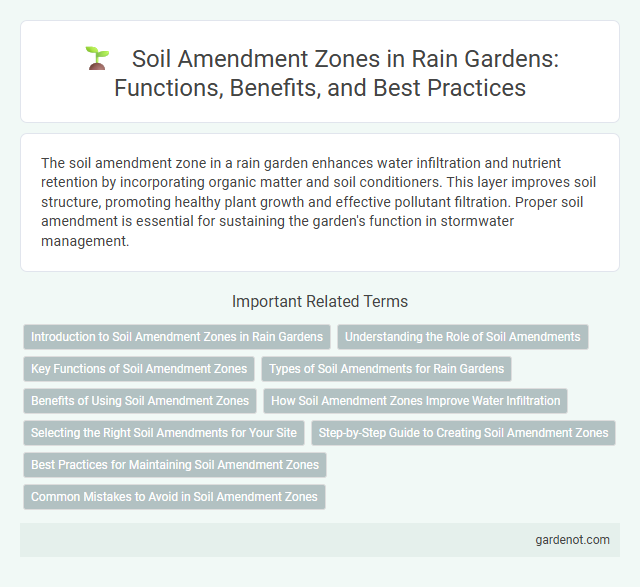The soil amendment zone in a rain garden enhances water infiltration and nutrient retention by incorporating organic matter and soil conditioners. This layer improves soil structure, promoting healthy plant growth and effective pollutant filtration. Proper soil amendment is essential for sustaining the garden's function in stormwater management.
Introduction to Soil Amendment Zones in Rain Gardens
Soil amendment zones in rain gardens are critical for enhancing water infiltration and plant growth by improving soil texture and nutrient content. These zones typically consist of a mix of sandy soil, compost, and organic matter to increase permeability and retain moisture while supporting native vegetation. Properly designed soil amendment zones help mitigate stormwater runoff, reduce pollutant loads, and promote healthy ecosystems within urban landscapes.
Understanding the Role of Soil Amendments
Soil amendments in a rain garden improve water infiltration, enhance nutrient retention, and support plant health by increasing organic matter and adjusting pH levels. Effective soil amendment zones reduce soil compaction and promote microbial activity, crucial for breaking down pollutants and maintaining soil structure. Understanding the specific needs of the native soil composition is essential for selecting appropriate amendments that optimize the rain garden's environmental benefits.
Key Functions of Soil Amendment Zones
Soil amendment zones in rain gardens enhance water infiltration and retention by improving soil structure and permeability. These zones support microbial activity and nutrient cycling, which are crucial for pollutant breakdown and plant health. They also stabilize soil to prevent erosion, ensuring long-term effectiveness of rain garden systems.
Types of Soil Amendments for Rain Gardens
Soil amendment zones in rain gardens are crucial for improving soil permeability and nutrient retention, enhancing water infiltration and supporting plant growth. Common types of soil amendments include compost, which boosts organic matter and microbial activity; sand or fine gravel to increase drainage; and biochar for soil aeration and carbon sequestration. Properly balanced soil amendments create an optimal environment for rain garden plants and maximize stormwater management efficiency.
Benefits of Using Soil Amendment Zones
Soil amendment zones in rain gardens improve water infiltration and enhance nutrient retention, promoting healthier plant growth and reducing runoff pollutants. These zones increase soil porosity and microbial activity, accelerating organic matter decomposition and improving soil structure. Incorporating soil amendments ensures optimal moisture levels and supports diverse native vegetation, contributing to effective stormwater management and ecosystem restoration.
How Soil Amendment Zones Improve Water Infiltration
Soil amendment zones enhance water infiltration by increasing soil porosity and permeability, allowing rainwater to penetrate deeper and more efficiently. Incorporating organic matter and sandy materials in these zones creates better soil structure, reducing surface runoff and promoting groundwater recharge. Improved water absorption in soil amendment zones supports healthier plant roots and reduces erosion in rain gardens.
Selecting the Right Soil Amendments for Your Site
Choosing the right soil amendments for a rain garden involves analyzing the native soil's texture, drainage, and pH levels to ensure optimal water infiltration and plant growth. Incorporate organic matter such as compost to enhance nutrient availability and soil structure, while using sand or perlite to improve drainage in heavy clay soils. Tailoring amendments to site-specific conditions maximizes stormwater retention and supports a healthy, resilient rain garden ecosystem.
Step-by-Step Guide to Creating Soil Amendment Zones
Create soil amendment zones in rain gardens by first identifying areas with poor drainage or compacted soil. Excavate the designated zones to a depth of 12-18 inches and mix in organic matter such as compost, aged mulch, or biochar to improve soil structure and nutrient retention. Finally, incorporate sandy loam or topsoil to enhance permeability and support native plant root systems, ensuring optimal water infiltration and plant health.
Best Practices for Maintaining Soil Amendment Zones
Maintaining soil amendment zones in rain gardens requires regular monitoring of soil texture and nutrient levels to ensure optimal water infiltration and plant growth. Incorporating organic matter such as compost enhances soil structure, promotes microbial activity, and improves moisture retention, critical for stormwater management. Periodic soil testing and avoiding soil compaction are essential best practices to sustain the amendment zone's effectiveness throughout seasonal cycles.
Common Mistakes to Avoid in Soil Amendment Zones
Common mistakes in soil amendment zones of rain gardens include over-amending with organic matter, which can impede drainage and create waterlogging. Using inappropriate soil types, such as heavy clay without proper blending, leads to poor infiltration and root growth. Neglecting to test soil pH and nutrient levels causes imbalanced conditions that hinder plant establishment and pollutant filtration.
Soil amendment zone Infographic

 gardenot.com
gardenot.com